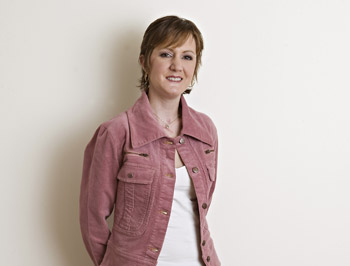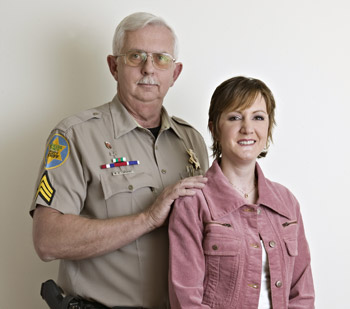When the unimaginable happens, survival requires the best from every member of the Level I Trauma team.

Erin, who originally thought about a career in law, is planning on nursing instead.
A slender, athletic 24-year-old who excels in yoga and piano, Erin McCormick is an honors grad who earned her B.S. at Arizona State University in just three years while working two jobs. She took the LSAT and planned on law school.
Although she’s competitive, she’s never seen herself as an extreme risk taker. But in April 2009 she was in for the greatest risk – her life.
It couldn’t have been more unexpected. Erin was peacefully floating on an inner tube in a cove on the north side of Lake Pleasant – when another boat backed up and sucked her into its propeller.
Erin can’t tell you much about her horrific injuries and miraculous survival; blessedly, she doesn’t remember.
But others saw the propeller whirl into the right side of Erin’s head and body, chopping her skull, jaw and face; shredding her shoulder, collarbone and torso; slashing her arm to the bone four times between elbow and wrist. Bleeding from her mangled flesh was prodigious; more urgently, her airway was compromised, which meant breathing was a challenge.
Immediately, our community’s lifesaving professionals sprang into action, starting with two off-duty nurses who kept Erin breathing until Maricopa County Sheriff ’s Sgt. Wayne Lupinski arrived in his patrol boat to provide emergency life support and transport to shore.
Mixed jurisdictions in Maricopa County’s outlying areas mandate multi-agency cooperation. The Sheriff has authority on the water. On shore, Peoria is responsible. In the sky, it’s the Department of Public Safety.
Peoria paramedics Maureen Shannon and William Johnston were there when Sgt. Lupinski docked. They stanched Erin’s bleeding while waiting for DPS. Eric Tarr, DPS, with Fred Grant, Phoenix Fire, kept Erin alive during the 12-minute flight to John C. Lincoln’s Level I Trauma Center.
“She was a ‘blue alert,’ the most critical trauma injury,” said trauma surgeon Peter Ferrara, MD.
When someone is that brutally, massively injured, how does the trauma team decide what to do first? “It’s not easy, but it is A-B-C,” Dr. Ferrara said. “A for airway – is it open? If obstructed by injury or blockage, it must be cleared first. B for breathing – if necessary, we’ll do that for the patient – and C for circulation. That means stop the bleeding, resuscitate the heartbeat and replace lost body fluids and blood – all at the same time!”
Dr. Ferrara immediately took Erin to surgery. While he worked, anesthesiologist Gerry Peiser, DO, “pushed” 40 units of blood into Erin’s hemorrhaging body at the rate of almost one per minute. A unit normally takes an hour to transfuse; 40 units is almost three times an adult’s blood volume.
“Dr. Ferrara was amazing and deserves a lot of credit,” commented reconstructive hand surgeon Lloyd Champagne, MD, “but the champion is the anesthesiologist.
“If you’ve never seen a trauma team in action, you cannot imagine the superhuman balancing act for an anesthesiologist to keep patients alive while putting them to sleep, all while performing heavy-duty physical labor keeping the blood supply replaced with nonstop transfusions and while tracking her electrolytes and other body chemistry every 20 minutes. Dr. Peiser did a masterful job.”
Dr. Peiser is a little more self-deprecating. He simply credited his success to his ability to move quickly under pressure.
Reconstructive surgeon Pablo Prichard, MD, did a brief surgery to prevent Erin’s mouth bacteria from infecting her exposed jawbones. “I would have preferred to do more at that time,” Dr. Prichard said. “The earlier you can repair nerve damage, the better the outcome. But Erin just wasn’t strong enough.”
She went to Intensive Care for further transfusions and stabilization while doctors reviewed X-rays and CT scans of her head, neck, chest, abdomen and pelvis.

Maricopa County Sheriff Sgt. Wayne Lupinski was one of a team of professionals who helped save Erin’s life.
At first, her skull injuries, a small fracture and a scalp laceration, seemed to be the least of her problems, said neurosurgeon Paul LaPrade, MD. “It only took about 45 minutes to fix them.”
After surgery Erin woke and was responsive, but a few hours later went into a coma with “the largest epidural hematoma (bleeding between her skull and the tough outer lining of her brain) I’ve ever seen,” Dr. LaPrade said.
Worse, it was squeezing her brain stem, which controls breathing. “The brain stem does not like to be depressed,” Dr. LaPrade said. “Permanent damage can happen very quickly.”
Erin was rushed back to surgery, where Dr. LaPrade evacuated the hematoma. But another CT scan showed recurrent and residual brain bleeding, so Erin went for a third neurosurgery.
“We finally stopped the bleeding,” Dr. LaPrade said. “But I thought if she lived, she’d be in a vegetative state. I felt so depressed.”
Yet in the morning, Erin was awake, following commands. “I was surprised, amazed, thrilled,” he said, “so happy for her family. Erin is the only patient I’ve had with her level of brain injury whose recovery is so complete. It’s a miracle.”
It was five days before Erin was strong enough for Dr. Prichard to put her delicate and beautiful face back together.
This is tricky business – each side of the face is controlled by a network of five microscopic major nerves that branch and sub-branch up and outward from the jaw.
In addition, the bony structure of the right side of Erin’s face was “much worse than a gunshot,” observed Dr. Prichard. “I had to rebuild her eye socket, her cheekbone and her jaw, all of which were in multiple pieces.”
Then it was time for the hand surgeon. “The human hand is amazing,” Dr. Champagne mused. “It can be expressive, a conductor guiding an orchestra; powerful, a workman tossing a 100- pound sack of cement; delicate, performing microsurgery; or emotional, petting a dog. Its anatomy and neurophysiology is so complex; it is irreplaceable. ”
Dr. Champagne used all his skills, “but don’t call me a hero,” he said. “The real hero is Erin. She’s that one patient in a thousand who works so hard, goes above and beyond with rehab and therapy, she makes all her surgeons look good.”
Erin has had several more operations to maximize her recovery and spent time pondering her future.
“She worked as a hospital volunteer when she was a teen,” said Erin’s mom, Carol McCormick. “She liked helping people, and now she’s planning on nursing instead of law school.”
“I am so grateful to all the amazing people who helped me,” Erin said. “I can never adequately express how much I appreciate everything that was done for me.”
Visit JCL.com/trauma for more information.